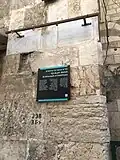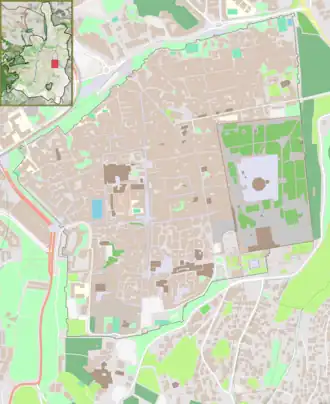Al-Khanqah as-Salahiyya Mosque
| Al-Khanqah as-Salahiyya Mosque | |
|---|---|
مسجد الخانقاه الصلاحية | |
 The mosque during the Ottoman period | |
| Religion | |
| Affiliation | Islam |
| Ecclesiastical or organizational status | Mosque and khanqah |
| Status | Active |
| Location | |
| Location | Christian Quarter, Old City, Jerusalem |
| Geographic coordinates | 31°46′43.68″N 35°13′45.53″E / 31.7788000°N 35.2293139°E |
| Architecture | |
| Style | Ayyubid, Ottoman |
| Founder | Ṣalāḥ ad-Dīn (Saladin) |
| Completed |
|
| Specifications | |
| Dome(s) | 2 (maybe more) |
| Minaret(s) | 1 |
The Al-Khanqah as-Salahiyya Mosque (Arabic: مسجد الخانقاه الصلاحية, romanized: al-Khānqāh aṣ-Ṣalāḥiyya, lit. 'the lodge of Saladin') is a mosque complex, located in the Christian Quarter of the Old City of Jerusalem, north of the Church of the Holy Sepulchre.[1][2][3] It was named after Saladin, who endowed it. As the name indicates, the complex was originally a khanqah, a place for gatherings of Sufi Islamic adherents, including dervishes. The complex today comprises the mosque as well as a school, a public sitting room, rooms for military officers, a dining room for wayfarers, small rooms for guards, and a very small room for Saladin’s spiritual retreat.[4]
History
The building is situated on the former palace of the Latin Patriarch of Jerusalem.
Following the Crusader surrender of Jerusalem to Ṣalāḥ ad-Dīn (Saladin) in 1187, it became al-Khānqāh aṣ-Ṣalāḥiyya. The building comprised a mosque, a school, a public sitting room, rooms for military officers, a dining room for wayfarers, and small rooms originally for guards, as well as a very small room for Salah ad-Din (Saladin)'s spiritual retreat. As the name indicates, it has also been a khanqah, a convent of Sufi adherents.[4]
The minaret was built in 1417, during the Mamluk period.[5][6] The minaret is almost identical to that of the Mosque of Omar, located on the other side of the Church of the Holy Sepulchre.[2] The two minarets were obviously designed as a pair; a line connecting the two minarets would intersect the door of the Tomb of Jesus inside the church, and the minarets are equidistant to that door[1] with their tops at exactly the same elevation despite starting at different ground levels.[7]
Gallery
-
.jpg) The 1936 Survey of Palestine map – the Khanqa mosque is number 35
The 1936 Survey of Palestine map – the Khanqa mosque is number 35 -

-

-
-

-
See also
References
- ^ a b "al-Khanqah al-Salahiyya Mosque - Madain Project (en)". madainproject.com. 2012. Retrieved June 18, 2022.
- ^ a b "Die "El-Khanqah as-Salahiyya Moschee" in Jerusalem" (Text and images). www.theologische-links.de (in German). Retrieved June 18, 2022.
- ^ "ISLAMIC AND CHRISTIAN HOLY PLACES" (PDF). PASSIA. n.d.
- ^ a b Murphy-O'Connor, Jerome (February 28, 2008). The Holy Land: An Oxford Archaeological Guide from Earliest Times to 1700. OUP Oxford. ISBN 978-0-19-152867-5.
- ^ Winter, Dave; Matthews, John (1999). Israel Handbook. Footprint Travel Guides. p. 147. ISBN 1-900949-48-2.
- ^ ed-Dyn, Moudjir (1876). Sauvaire (ed.). Histoire de Jérusalem et d'Hébron depuis Abraham jusqu'à la fin du XVe siècle de J.-C. : fragments de la Chronique de Moudjir-ed-dyn (in French). p. 169.
- ^ Murphy-O’Connor, J. (2008). The Holy Land: An Oxford Archaeological Guide from Earliest Times to 1700. Oxford Archaeological Guides. Oxford: Oxford University Press. p. 62. ISBN 978-0-19-923666-4. Retrieved June 20, 2016.
Further reading
- Berchem, van, M. (1922). MIFAO 43 Matériaux pour un Corpus Inscriptionum Arabicarum Part 2 Syrie du Sud T.1 Jérusalem "Ville" (in French and Arabic). Cairo: Impr. de l'Institut français d'archéologie orientale. pp. 87−91.
- Burgoyne, Michael Hamilton (1987). Mamluk Jerusalem. British School of Archaeology in Jerusalem by the World of Islam Festival Trust. pp. 517−518. ISBN 090503533X.
External links
- Al-Khanqa al-Salahiyya
- al-Khanqah al-Salahiyya Archived 2021-05-12 at the Wayback Machine

